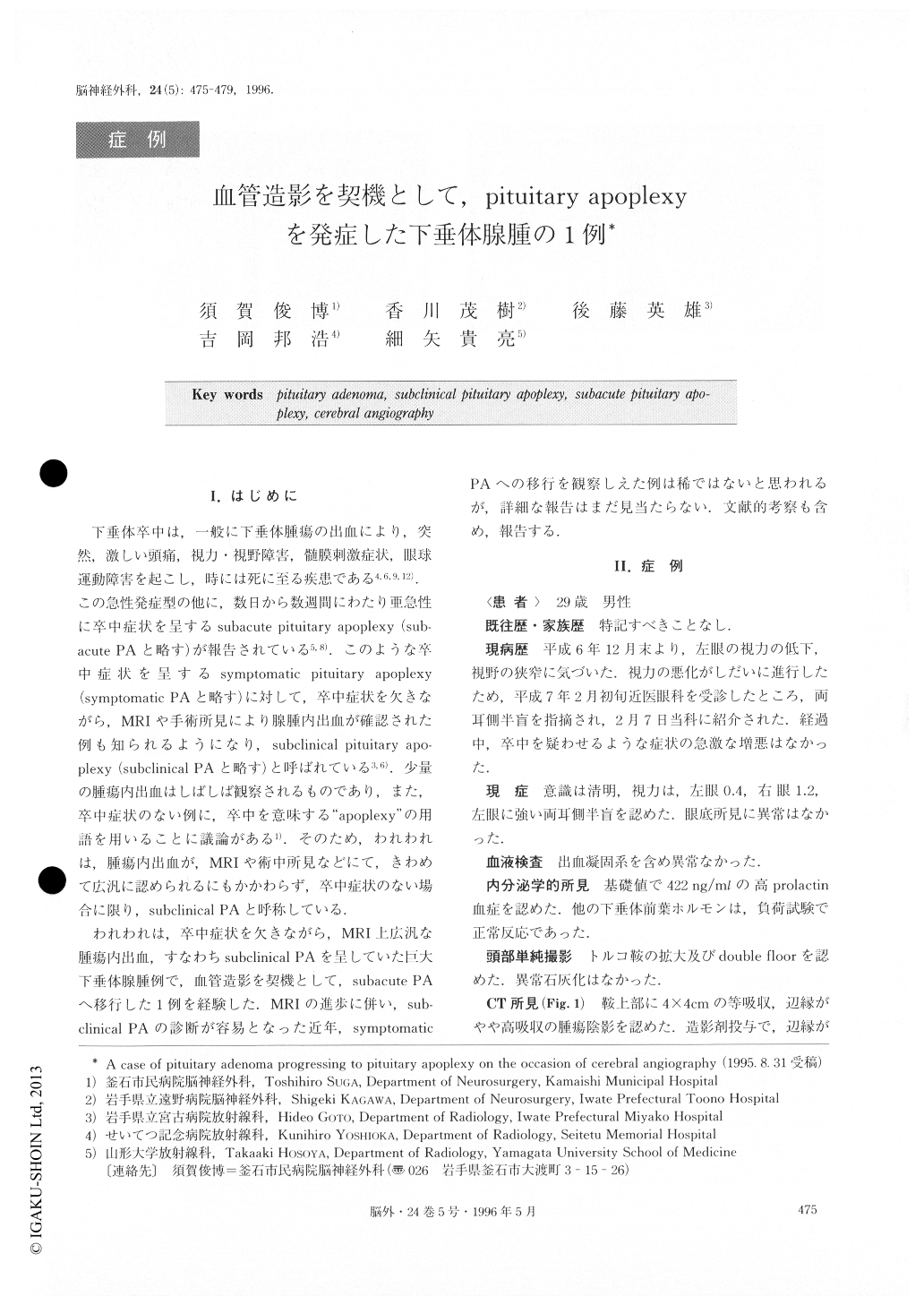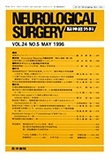Japanese
English
- 有料閲覧
- Abstract 文献概要
- 1ページ目 Look Inside
I.はじめに
下垂体卒中は,一般に下垂体腫瘍の出血により,突然,激しい頭痛,視力・視野障害,髄膜刺激症状,眼球運動障害を起こし,時には死に至る疾患である4,6,9,12).この急性発症型の他に,数日から数週間にわたり亜急性に卒中症状を呈するsubacute pituitary apoplexy(sub—acute PAと略す)が報告されている5,8).このような卒中症状を呈するsymptomatic pituitary apoplexy(symptomatic PAと略す)に対して,卒中症状を欠きながら,MRIや手術所見により腺腫内出血が確認された例も知られるようになり,subclinical pituitary apo—plexy(subclinical PAと略す)と呼ばれている3,6).少量の腫瘍内出血はしばしば観察されるものであり,また,卒中症状のない例に,卒中を意味する“apoplexy”の用語を用いることに議論がある1).そのため,われわれは,腫瘍内出血が,MRIや術中所見などにて,きわめて広汎に認められるにもかかわらず,卒中症状のない場合に限り,subclinical PAと呼称している.
われわれは,卒中症状を欠きながら,MRI上広汎な腫瘍内出血,すなわちsubclinical PAを呈していた巨大下垂体腺腫例で,血管造影を契機として,subacute PAへ移行した1例を経験した.MRIの進歩に併い,sub-clinical PAの診断が容易となった近年,symptomatic PAへの移行を観察しえた例は稀ではないと思われるが,詳細な報告はまだ見当たらない.文献的考察も含め,報告する.
A case of pituitary adenoma which had progressed from subcilnical pituitary apoplexy to subacute pituit-ary apoplexy on the occasion of cerebral angiography is reported.
A 29-year-old man, complaining of bitemporal hemianopsia, was admitted to our department. Plain skull X-p revealed enlargement and double floor of the sella turcica. No abnormal calcification was revealed. CT demonstrated an isodensity mass with a diameter of 4×4cm, and with ring enhancement in the suprasellar region. The mass extended from the intrasellar region to the suprasellar region and had a signal of high in-tensity on T1-weighted images. Endocrinological ex-amination revealed hyperprolactinemia with a serum level of 422ng/ml and normal rection of anterior pitui-tary hormones. On 3rd March, digital subtraction angiography with 5F catheter was performed with the patient under sedation. The contrast medium was iox-aglic acid (Hexabrix 320®). A volume of 6ml with a speed of 4ml per second was injected for the internal carotid angiogram. A total volume of 60ml was used. Serum saline with 10 unit per ml of heparin sodium was also used for flushing. During angiography, the pa-tient's blood pressure was 125/60-115/60mmHg. DSA revealed upward displacement of the proximal portion of the anterior cerebral artery, pocket formation, and staining of the tumor capsule. Six hours later, he com-plained of retroorbital headache. Next morning, he noticed complete lack of left visual acuity. On 7th March, right visual acuity degenerated to blindness. CT revealed that the mass had increased its density. With bifrontal osteoplastic craniotomy, the tumor with marked intratumoral hemorrhage was resected. Its his-tology was chromophobe adenoma. The patient's right visual acuity improved rapidly.
On the occasion of cerebral angiography, we could observe that subclinical pituitary apoplexy deteriorated to subacute pituitary apoplexy. Rosenbaum postulated that injection of contrast media increased intravascular pressure leading to pituitary apoplexy. At present, we cannot postulate increased intravascular pressure with 5F catheter and DSA. We cannot rule out that, with underlying subclinical pituitary apoplexy, hemorrhagic infarction due to contrast media and the anti-coagulate effect of heparin sodium accelerated the intratumoral bleeding. Subclinical pituitary apoplexy is a vulnerable state because of its aggravation to symptomatic apo-plexy under mild stress. We emphasize that an opera-tion should be performed as early as possible in the case of subclinical pituitary apoplexy.

Copyright © 1996, Igaku-Shoin Ltd. All rights reserved.


